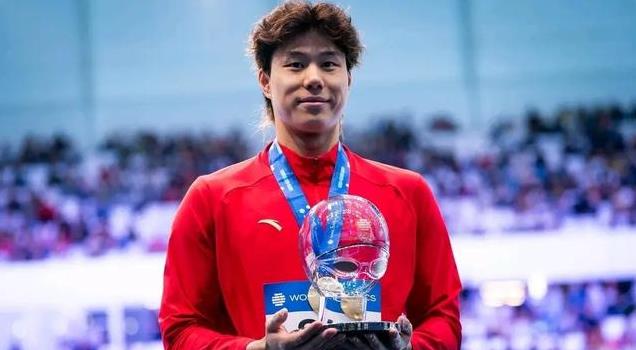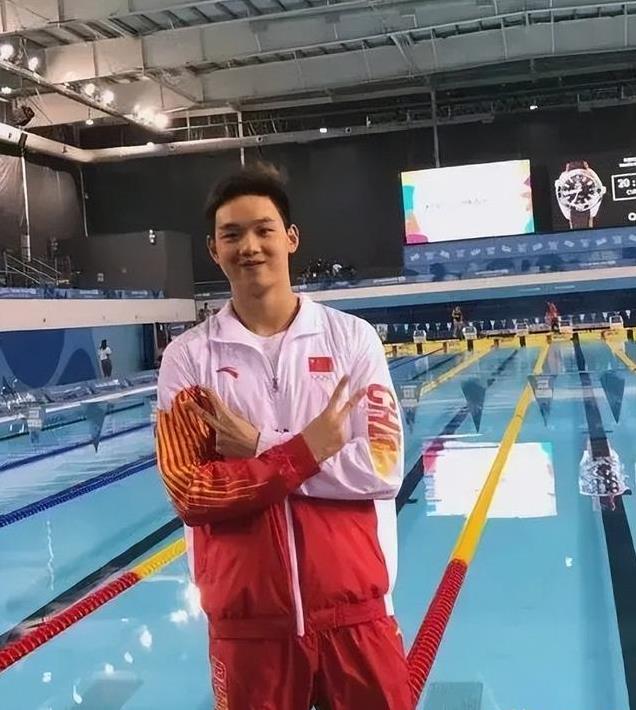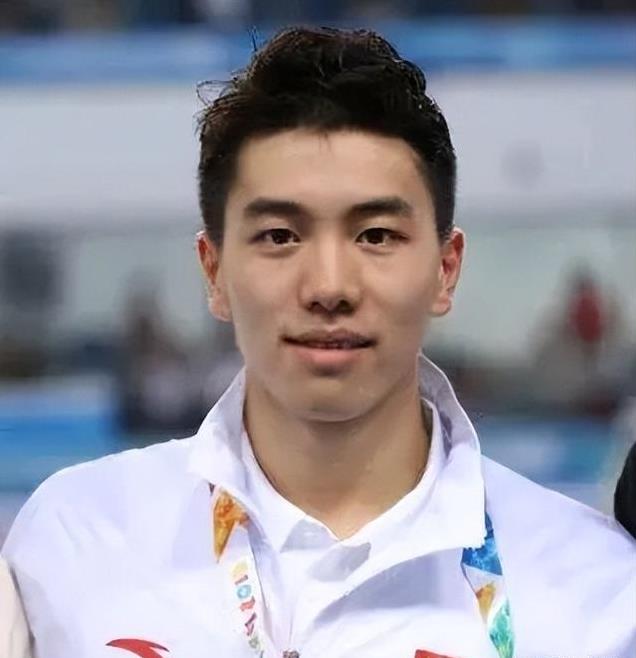In the swimming arena of the Paris Olympics, it is truly a grand stage where passion and glory intertwine! The moment the young men of China's men's swimming team dive into the pool, it's as if they've embarked on a legendary journey.
Take Pan Zhanle for example, his speed is like lightning in the men's 100m freestyle event, breaking world records and Olympic records. When he crosses the finish line, the whole stadium goes wild with cheers and shouts that are deafening. The five-starred red flag waves high in the wind, and the world remembers this young champion.
Now, everyone is eagerly looking forward to the Los Angeles Olympics in the United States, wanting to see what new achievements China's men's swimming team can achieve there, and who will continue to create brilliance.
Let's start with Pan Zhanle, born in 2004, standing at 1.92 meters tall and weighing 80 kilograms, he is a swimming prodigy! He started swimming from a young age, and his journey has been like leveling up in a game, which hasn't been easy.
When he first started training, the intensity was so great that it exhausted him, but he just loves swimming and gritted his teeth to persevere.
Looking at his current achievements, he won the gold medal in the men's 100m freestyle at the 2024 Paris Olympics, which is of great value.
At the 2023 World Swimming Championships, he also performed impressively, breaking Asian records and winning championships in events such as the men's 4x200m relay, 4x100m relay, and 100m freestyle.
He is the first Chinese athlete to win an Olympic gold medal in the men's 100m freestyle, and many records from the World Championships, Olympics, and Asian Games belong to him.
Pan Zhanle's swimming skills are incredibly impressive.
His explosive power is super strong, like a little bomb, and when he starts and sprints, that force bursts out instantly.
His legs are so powerful that every kick is like putting an engine in the pool.
Compared to those foreign champions, his explosive power data is even better.

His swimming posture is very scientific, with not much splash when he strokes, because his body coordination is good and his sense of water is accurate.
His breathing skills are also top-notch, able to breathe accurately and well while swimming so fast, which makes his anaerobic exercise ability strong and his endurance good.
The frequency of his strokes is also just right, as if calculated, to maximize the use of the water's counterforce.
Speaking of the Los Angeles Olympics, it's not easy for Pan Zhanle. International swimming competitions are becoming increasingly fierce, with new opponents emerging in droves.
Just like those young American swimmers, their short-distance freestyle has improved rapidly, and their training methods and competition tactics need to be carefully studied.
Moreover, the competition rules have changed, with higher requirements for athletes' starts and turns.
However, Pan Zhanle hasn't been idle. His coaching team has formulated a more scientific training plan based on these changes, focusing on strengthening his techniques and adding a lot of tactical training for different situations, waiting to achieve another good result at the Los Angeles Olympics.
Tan Haiyang is also a formidable figure, born in 1999, standing at 1.90 meters tall and weighing 90 kilograms.
At the 2023 Fukuoka, Japan Swimming World Championships, he won three gold medals in the 50m, 100m, and 200m breaststroke events, breaking the world record in the 200m breaststroke and the Asian record several times. He is the backbone of China's men's swimming team! He has achieved today through tremendous effort.
During training, in order to improve his stroke technique, he tried countless times, failing and trying again, refining every small action. Both he and his coach put in a lot of effort.
Tan Haiyang's strokes are both efficient and delicate, which is the secret to his dominance in breaststroke.
Scientifically speaking, he can make the water resistance particularly small and the propulsion particularly large when he strokes, as if dancing in the water, with precise and beautiful movements.

During the sprint, his explosive power surges, leaving his opponents far behind.
Compared to other top breaststroke swimmers, his technique is stable, whether it's the beginning or the end of the race, and he has a good grasp of the rhythm.
Relying on this sense of rhythm, he can reasonably allocate his strength and exert his full strength at critical moments.
In relay races, Tan Haiyang is like a stabilizing force.
He is adept at adjusting tactics based on his teammates' conditions and the race situation.
During baton exchanges, he grasps the timing and speed perfectly, coordinating seamlessly with his teammates.
Before the race, he also encourages his teammates, sharing his experience with everyone, instilling confidence and unity throughout the team.
Hong Jinquan is no simple opponent either, born in 2003, standing at 1.95 meters tall and weighing 91 kilograms, he is a rising star of China's men's swimming team.
Starting from winning a bronze medal in the mixed relay at the Youth Olympics, he has continued to move forward, winning championships in the men's 4x100m, 4x200m, and 4x200m medley at the National Games, and also winning the championship in the men's 4x100m freestyle relay at the Asian Games.
His journey has not been smooth sailing either. When he loses a match, he feels down and doubts himself, but he can quickly adjust and learn from failure.
Everyone calls him Little Sun Yang. He has well-developed muscles and strong explosive power, but more importantly, he has that demeanor in major competitions.
Under such pressure in relay races, he can still hold steady.

Just like in the relay final at the Asian Games, the atmosphere was tense, but he relied on his psychological quality and explosive power to gain a significant advantage for the team.
He is aware of his importance in relays, and his cooperation with his teammates is getting better and better.
During training, they keep practicing baton exchanges and studying how to arrange relay orders based on opponents' situations.
By the time of the Los Angeles Olympics, he will have more experience and better techniques, and may become the leading figure in relay events, leading the team to achieve good results.
Sun Jiajun, born in 2000, stands at 1.78 meters tall and weighs 67 kilograms, is a national-level athlete.
His swimming career is also a history of struggle.
From winning gold medals in the men's 100m breaststroke and 4x100m at the 2017 Buenos Aires Youth Olympics to the Tokyo and Paris Olympics, he has become increasingly mature in terms of technique and mentality.
To improve his side-stroke technique, he has put in a lot of effort, doing specialized training and not letting go of any detail.
Sun Jiajun has many technical advantages.
His starting reaction is incredibly fast, like lightning, allowing him to take the lead as soon as the race begins.
His swimming posture is standard, with smooth actions, each movement is as if designed, and his stroke technique is good, maintaining a stable speed in the water.
Side-stroke technique is his forte. When nearing the edge of the pool, he can accurately judge the distance and speed, making particularly appropriate movements, relying on which he often overtakes others in competitions.

His psychological quality is also excellent. No matter how great the pressure of the competition is, he can calm down and perform at his best.
The competition at the Los Angeles Olympics is even more intense. During training, he continuously strengthens his advantages and adjusts his mentality to prepare for the challenges ahead.
There's also Chen Juner, born in 2004, standing at 1.80 meters tall and weighing 70 kilograms, a promising star in butterfly.
He won the championship in the men's 200m butterfly at the 14th National Games Swimming Competition in 2021, and the championship in the 2023 National Swimming Championships is also his, breaking the national record. He also contributed to the victory in the men's 4x100m freestyle relay at the Hangzhou Asian Games, breaking the Asian record.
During training, he discovered his talent in butterfly and then focused all his efforts on it.
Chen Juner's butterfly technique has many highlights.
His stroke rhythm is unique, as if in sync with the water, gaining force with each stroke.
His turning technique is also good. He can quickly adjust his body during turns, reducing resistance without losing speed.
Compared to those top international butterfly swimmers, his technique is becoming increasingly refined.
For the Los Angeles Olympics, he formulated a training plan based on his own situation, focusing on improving speed and endurance. His coaches also have great confidence in him, hoping that he can bring new breakthroughs to China's men's swimming team in the butterfly event.
China's men's swimming team is a formidable collective, and the coaching staff is particularly important.
Coaches formulate specialized training plans for each athlete based on their characteristics and development stages.
During relay training, special attention is paid to cultivating默契 between team members, simulating race scenarios, analyzing opponents' situations, and preparing the athletes to handle various situations during the race.
In terms of psychology, there is also professional counseling to help athletes maintain a good mindset under pressure.
Looking internationally, the United States and Australia are formidable swimming powers.
The United States has a complete system for cultivating talent, with new outstanding